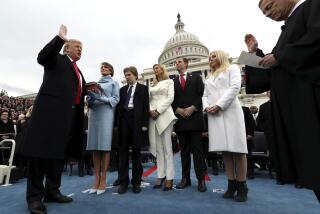Church and state: Blurring the line
LAST WEEK, THE U.S. Department of Health and Human Services suspended a $75,000 grant to the Silver Ring Thing, a sexual abstinence program for teenagers, saying it was concerned that the program âmay not have included adequate safeguards to clearly separate in time or location inherently religious activities from the federally funded activities.â
The silver ring in the programâs title refers to a ring worn by participants. It is inscribed with the message, âGod wants you to be holy, so you should keep clear of sexual sin.â The ACLU had charged that the Silver Ring Thing used âtaxpayer dollars to promote religious content, instruction and indoctrination.â A lawyer for the program, which has received about $1.3 million in federal funds since 2003, insisted that âany religious teaching that goes on is separate in time and place from what the government is funding.â
I donât have the information to pronounce confidently on whether the Silver Ring Thing crossed the legal line. I have some sympathy, however, for those who would expect Washington to approve of abstinence rings with a religious inscription. Thatâs because, from its inception, the campaign to provide government-funded social services through religious institutions has depended on two difficult-to-reconcile rationales.
One is a simple nondiscrimination principle: supporting equal access for religious groups to government social-service funding. As Bush put it in a speech to the National Hispanic Prayer Breakfast in 2002: âWhen it comes to the use of federal money, the days of discriminating against religious institutions simply because they are religious must come to an end.â
But Bush also has flirted with a long-held principle of those who advocate subcontracting to faith groups such services as alcohol detoxification, prisoner rehabilitation and campaigns against teenage pregnancy. Their more grandiose justification is this: Precisely because they rely on religion to transform lives, faith-based initiatives are not just equal to but superior to their secular equivalents.
This paradigm is nicely illuminated in an anecdote about the Nixon hatchet-man-turned-evangelist Charles Colson.
In âCharles W. Colson: A Life Redeemed,â Colson biographer Jonathan Aitken quotes Colsonâs description of his visit to a Brazilian prison run on Christian principles in which a cell once used for torture has only one occupant -- a large wooden crucifix that had been carved by the inmates. âHeâs doing time for all the rest of us,â Colsonâs guide told him.
Colson âalways linked the remarkable spirituality he had seen in a Humaita prison to the jailâs no less remarkable repeat-offending statistics,â Aitken says. The message was that scaring prisoners straight is less efficacious than blessing them straight.
This, in a nutshell, is the âvalue-addedâ vision of a faith-based initiative. In that same 2002 speech to the Hispanic Prayer Breakfast, the president (even as he trumpeted the nondiscrimination principle) said about religious groups, âThese groups, these platoons in the armies of compassion ... inspire life-changing faith in a way that government never should.â
Ira C. Lupu, a George Washington University law professor who tracks legal decisions on faith-based charities, sees Bushâs sympathy for the value-added notion arising from the presidentâs own experience of putting alcohol behind him with the help of a born-again evangelical commitment. Yet Bushâs 2002 executive order setting up the faith-based program bars the use of federal funds âto support any inherently religious activities, such as worship, religious instruction or proselytization.â
It wouldnât be surprising if that distinction were lost on some of the foot soldiers in the army of compassion. Indeed, Lupu told me that litigation over ambiguities in the faith-based regulations is an old story.
âA worship service in a synagogue or a church or a mosque -- thatâs purely religious,â Lupu said. âReligious instruction in the Sunday-school sense, when you learn about theology and the customs and culture of a faith -- that also seems purely religious, though it would have incidental benefits about learning to read and write.â
But Lupu said the Bush administration had been âstudiously silentâ when he and his academic partner asked whether the ban on âinherently religiousâ activities applied to âsocial services with religious themes and content.â
The administration may have no good answer to the question of whether a federally funded social service can be both secular and religious, though the Health and Human Services action indicates there is some limit.
Scripture, however, may offer the soundest advice. In the Gospel of Matthew, Jesus says: âNo man can serve two masters: for either he will hate the one, and love the other; or else he will hold to the one, and despise the other. Ye cannot serve God and mammon.â
More to Read
Sign up for Essential California
The most important California stories and recommendations in your inbox every morning.
You may occasionally receive promotional content from the Los Angeles Times.











